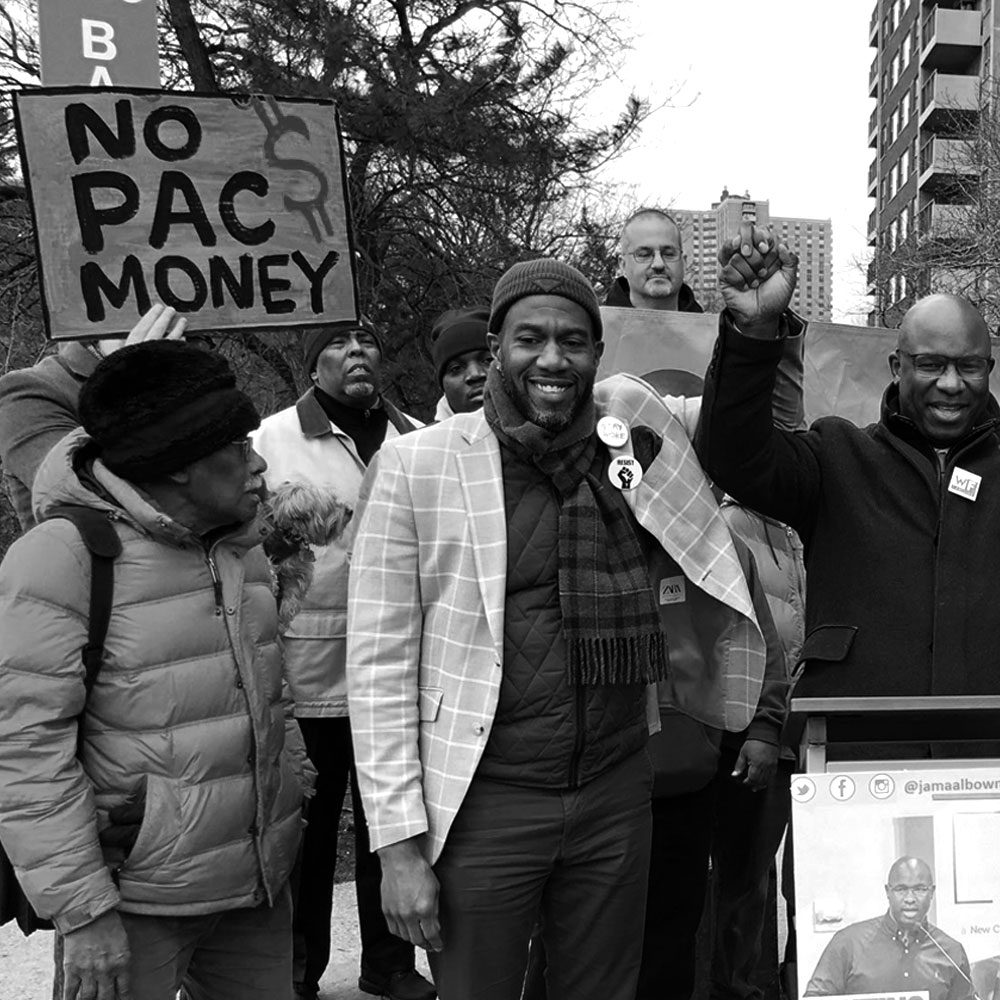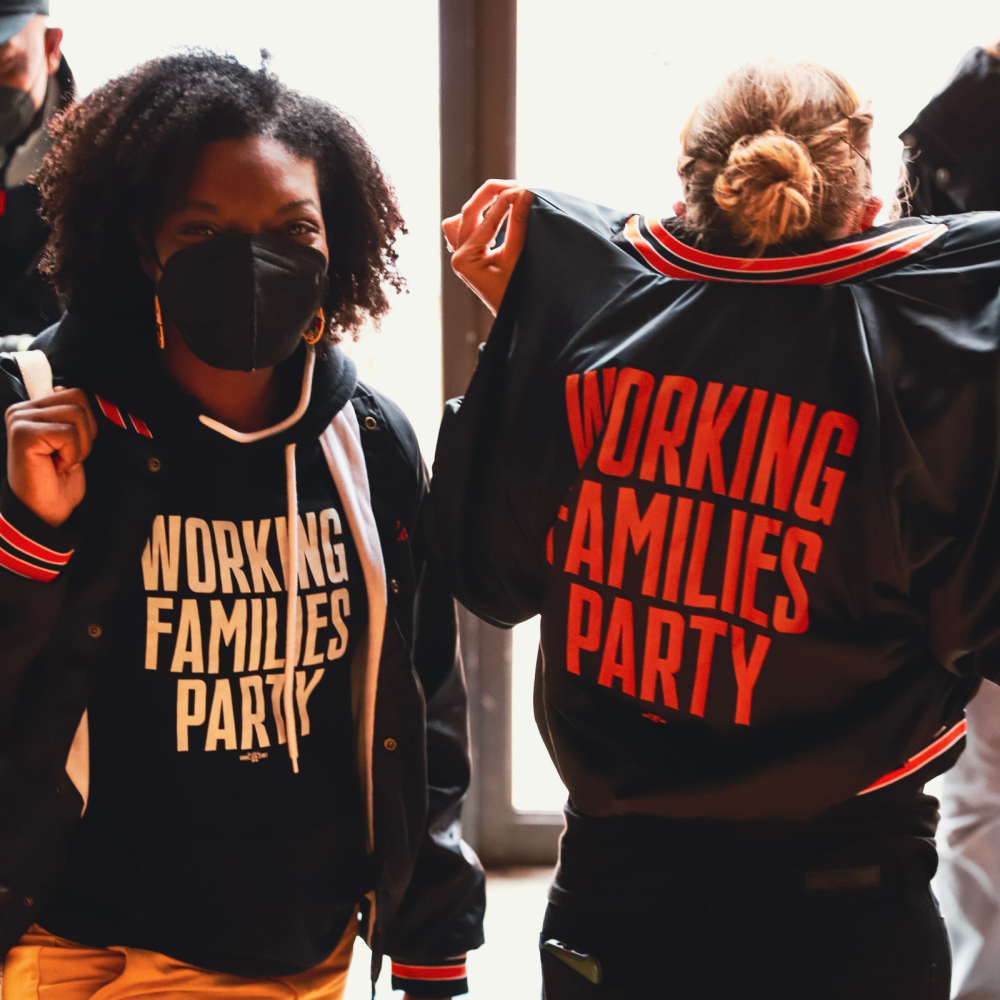WFP Membership: FAQ
What do WFP members do?
WFP members are involved in different ways, big and small! From elections to issue advocacy, it’s a true “get in where you fit in” environment. Many members follow WFP in the media and take action by signing petitions or reaching out to their representatives on key issues. Others join our volunteer events to contact voters by text, phones or hit the pavement in support of WFP champions.
WFP members also take on leadership roles within the party; some folks co-lead the national WFP Text Team, others join their local WFP affiliate and participate with fellow members at home in their communities. Members sometimes help identify and recruit candidates to run for office, participate in endorsement interviews, mobilize and campaign for WFP champions to win and after election day, and hold them accountable to co-govern with us once in office. As a member, you also get to vote on important decisions affecting the direction of the party. There are so many ways to participate in our party’s work.
Why should I become a dues-paying WFP member?
To achieve our long-term vision of a society rooted in equality, dignity, solidarity, and compassion requires building governing power by and for the multiracial working class. It means out-organizing what organized capital has bought. That’s why we formed a party — a group of individuals that organize together to engage in elections to advance a transformative structural change platform that locks in real gains for working class people.
The Working Families Party model — and especially our success over the last few years—provides a promising roadmap to progress: building a truly multiracial, working class coalition capable of building the governing power required to make our nation one that truly cares for us all.
We have a history of winning concrete improvements for the working class, including but not limited to:
- Seven state $15 minimum wage increases, 11 state paid family leave or sick day policies, and pay equity legislation in two states.
- Progressive revenue in New York, including $2.1 billion to distribute relief to workers excluded from other federal relief—mainly undocumented immigrants.
- Democracy reforms, including small-dollar public financing, state/federal primary consolidation, and automatic voter registration in New York; mass mail-in voting in New Jersey; Native voter access protection and improved mail-in voting in New Mexico; and public financing and the restoration of voting rights to incarcerated people in DC.
- $15 million cut from DC’s police budget, with funds reallocated toward community programs, while securing far-ranging police and justice reforms.
- Historic public investments in New Mexico schools and crucial funds for Milwaukee, WI’s schools as they dig out from the wreckage of the Walker years.
- Expanding public consciousness and the limits of what is possible, including tectonic shifts around taxing the rich, climate, and spending toward the public good that have taken large-scale investments like Build Back Better out of the fringe and into the mainstream.
However, if we are to build political power for the working class year after year, race after race, we need sustained political funding by our people. This allows us to:
- Build the progressive movement’s electoral engine, fueled by and for our working class membership, and integrate smooth cycles of elections, legislative advocacy, and movement building.
- Continue developing nationwide non-delusional leaders—leaders who don’t just determine what’s wrong, but set a clear-headed path to power to make things different.
- Counter the Democratic Party leadership’s focus on self preservation and make a principled push for the most visionary agenda for working people.
- Run essential programs in off-cycle time periods to build our base, leadership, and candidate and campaign staff pipelines.
- Work in deep alignment with candidates at the earliest stages of their campaigns in their primary and general elections.
What if I’m not a citizen of the USA?
Under federal law, “foreign nationals” — anyone who isn’t an American citizen or green card holder — may not make contributions to or participate in decision making for a political organization. If you still want to support our goals, you can make a monthly contribution to our ally Working Families Power, a 501(c)(4) organization that works to build the power of the multi-racial working class through organizing and advocacy across the country. Click here.
What if I’m not ready to become a dues-paying member?
You should learn more about the Working Families Party and get involved in your area! Here are two easy steps to get started:
- Learn more about us:
- Get a sense of WFP’s vision and values by taking a look at our endorsed candidates and recent news highlights.
- Attend a WFP Welcome Gathering, where you can meet other WFP members and learn more about our vision and strategy. We hold Welcome Gatherings on a monthly basis; sign up here for the next one.
- Join us at another upcoming WFP event or volunteer opportunity, either online or in your community.
- Work with us:
- One of the best ways to get involved is in your local community and we have a growing number of WFP affiliates across the country. See if there’s a local WFP affiliate in your area! You can search by zip code here for events and opportunities near you.
- Join our National Text Team! Nearly every Tuesday, we come together to text with voters about key races and issues.
How do I know if I’m a dues-paying member?
Go to https://secure.actblue.com/signin. If you contributed with a Gmail account, click the “sign in with Google”. If you contributed with another kind of email, click “create an account” and use the email you made your transaction with and add a password.
Select “Recurring” from the left panel. If you are a dues-paying member, you will see a recurring donation to WFP there of at least $10 a month.
If you still have questions, contact us at member@workingfamilies.org
What is the difference between a member and a dues-paying member?
General individual members of WFP are defined as individuals who state their intent to join as a member (including through actions such as online actions, contributions, and signups) and either pay regular membership dues or otherwise annually reaffirm their intent to remain a member.
Dues-paying members are defined as individuals who contribute $10 or more a month or $120 in the past year. Dues-paying members receive a package with WFP swag, and receive 15% off at our WFP store and occasional discounts at WFP events.
My voter registration is with the Democratic or other party. Can I still become a dues-paying member?
Yes! Becoming a member of WFP does not change your voter registration. Many WFP members choose to keep their voter registration status as Democrat so they can participate in closed elections where WFP endorsed candidates are running on the Democratic Party line. Whether your voter registration is with the Democratic Party, another party, or unaffiliated, you can still join as a WFP member.
What about in Connecticut, New York and Oregon?
In Connecticut, New York, and Oregon, the Working Families Party has statewide ballot access and you can vote on the Working Families Party line. In those states, you can choose to change your voter registration status to Working Families Party. However, changing your voter registration status to WFP is not necessary to join as a dues-paying member.
I’m going through a really hard time financially, but I still want to become a member. What should I do?
If you’re unable to contribute at this time, we’d still love you to be a part of the WFP as a member! If you’re not already a member, add your name here to join us and then search by zipcode for events and opportunities near you to get involved.
How to change your monthly dues amount
- Go to https://secure.actblue.com/signin
- If you contributed with a gmail account click the “sign in with google”. If you contributed with another kind of email, click “create an account” and use the email you made your transaction with and add a password.
- (If you have an admin act blue account, you may need to select “Manage” in the top right navigation, and click “Contributions” in the drop down menu)
- Select “Recurring” from the left panel
- Click on the appropriate recurring contribution
- At the bottom select the gear that says “Change recurring settings”
- On the Recurring Settings page you will be able to change the amount, how long it recurs (blank means unlimited until you cancel) and then click save.

